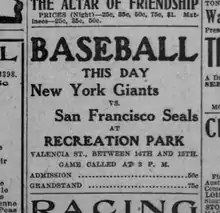Recreation Park was the name applied to several former baseball parks in San Francisco, California in the late 19th century and early 20th century.
Recreation Grounds, opened on November 26, 1868, and operated until May 1884, and was San Francisco's first professional enclosed ballpark. Located at the terminus of a railcar line in San Francisco's heavily Irish Mission District, at the present day Garfield Square.[1][2] The ballpark was bordered by the streets Harrison, Twenty-Sixth, Folsom and Twenty-Fifth.[3] The opening day ceremonies included the second game of the California baseball championship series between the Oakland Wide Awakes and the San Francisco Eagles, who won by the score of 37–23. The day's festivities included an operatic concert and footraces and were attended by a crowd of 4,000 people.[4] 37°45′1.78″N 122°24′47.78″W / 37.7504944°N 122.4132722°W Photo.
Haight-Street Recreation Grounds 1886[5] -1895. Another recreation grounds existed in the Haight, with ownership transferred to J.B. Gilbert of the Central league on September 8, 1893.[6] and was also referred to as Haight-Street Recreation Park located between Stanyan, Waller, Cole and Frederic Streets was closed in 1895.[7]
Central Park, also sometimes called Recreation Park, seating capacity of 15,000, opened on Thanksgiving Day of 1884[8] and operated until 1906.[9] Located at 8th Street and Market Streets, was used by several clubs including the San Francisco Seals of the Pacific Coast League from 1903. Destroyed by the earthquake and fire on April 18, 1906. The Seals temporarily moved to Oakland while the city of San Francisco was being rebuilt. Photo.
Recreation Park opened in September 1897 for local baseball and football. An early event was the Cal-Stanford Big Game that November. The hastily constructed stands suffered a partial collapse, but there were no fatalities. The following spring, the San Francisco Olympics, also known as the Athletics and the Brewers, began operating in the California League. The ball club lasted through the 1901 season. In 1903, the San Francisco Seals began their long run in the Pacific Coast League. They played at this ballpark until the 1906 San Francisco earthquake put them out of business for a while.
The ballpark was located on a block bounded by 8th Street (northeast, first base); Harrison Street (southeast, third base); Gordon Street (southwest, left field); and Ringold Street (northwest, right field).

Recreation Park, located in the Mission District 37°46′1.87″N 122°25′23.93″W / 37.7671861°N 122.4233139°W, was the best known and longest-lived of these ballparks. It was the home of the Seals during 1907–13 and then 1915–30 after a one-year experiment playing at newly built Ewing Park near the Richmond District. The experiment was a fiasco, largely because of the cold and foggy summer weather endemic to western San Francisco. The Oaks, in turn, had essentially moved into Recreation Park in 1907 and played most of their games there (except Thursdays and Sunday mornings) until their new Oaks Park was opened in 1913, although they continued to play some games in San Francisco until sometime in the 1920s. This congenial arrangement was made easier by the fact that J. Cal Ewing, founding father of the PCL, owned both clubs for their first couple of decades. The ballpark sat 15,000. It also become the home of the Mission Reds (a.k.a. "Missions") upon their arrival in 1926.
The Chicago White Sox held spring training at Recreation Park in 1909 and 1910.[10][11]
This final incarnation of Recreation Park was on a block bounded by 14th Street (north, right field); Valencia Street (east, first base); 15th Street (south, third base); and Guerrero Street (west, left field) 37°46′2.7″N 122°25′23.32″W / 37.767417°N 122.4231444°W. The stands were an unusual design, with a small lower deck topped directly above (thus protected from the weather) by a large upper deck, much of which was unroofed and open to the sunshine and the elements. The stands were also made of wood. A new, concrete ballpark called Seals Stadium, less than a mile east of Recreation Park, opened in 1931 as the new home of both the Seals and the Missions. Recreation Park was demolished and the site was converted into a public housing project.

See also
References
- ↑ "The San Francisco Call newspaper, July 7, 1907". 7 July 1907. p. 4. Retrieved 2009-09-05.
- ↑ "Sacramento daily record-union newspaper. (Sacramento [Calif.]) May 9, 1884". 9 May 1884. p. 5. Retrieved 2009-09-05.
- ↑ Zingg, Paul J.. Harry Hooper: An American Baseball Life Sport and Society, Page 46, University of Illinois Press, 2004 ISBN 978-0-252-07170-6
- ↑ "Daily Alta California - November 27, 1868".
- ↑ FoundSF.org
- ↑ "The San Francisco Morning Call, September 9, 1893". 9 September 1893. p. 8. Retrieved 2009-09-05.
- ↑ "The San Francisco Morning Call newspaper, March 1, 1895". March 1895. p. 11. Retrieved 2009-09-05.
- ↑ Daily Alta California newspaper, Volume 37, Number 12601, pg 8, 13 October 1884
- ↑ Franks, Joel (2001). Whose baseball?: the national pastime and cultural diversity in California, 1859-1941. Issue 19 of American sports history series. Scarecrow Press. p. 56. ISBN 9780810839274.
- ↑ "The Baseball Guru - MLB SPRING TRAINING LOCATIONS BY FRANCHISE SINCE 1900 by Kevin Saldana".
- ↑ Fountain, Charles (2009). Under the March Sun: The Story of Spring Training. Oxford University Press, USA. pp. 269. ISBN 978-0-19-537203-8.
Further reading
- Ballparks of North America, Michael Benson, McFarland, 1989, p. 362-363
- Take Me Out to the Ball Park, Lowell Reidenbaugh, The Sporting News, 1983 & 1987 p. 256
- Lost Ballparks, Lawrence S. Ritter, Viking Studio Books, 1992, p. 169-170
External links
- early years before upper deck was extended
- 1927 game-action photo
- 1931 Aerial View showing Recreation Park (toward upper left) and then-new Seals Stadium (toward lower right)]
- 1887 photo of the Haight and Stanyan baseball park.
- undated photo of Recreation Grounds baseball